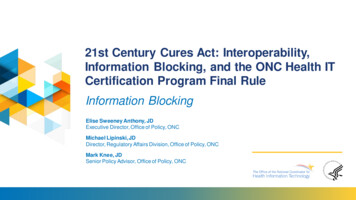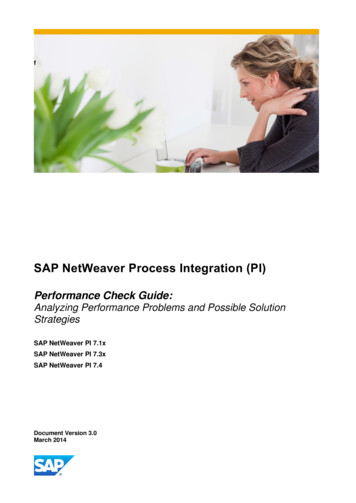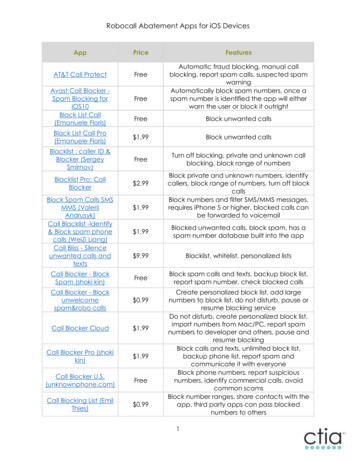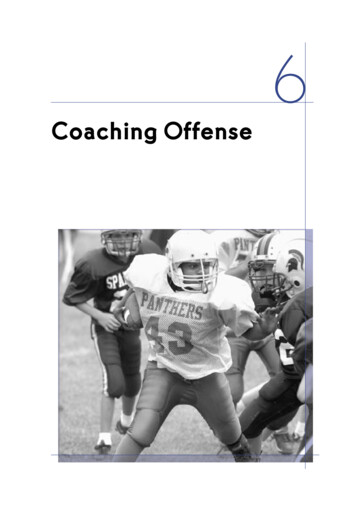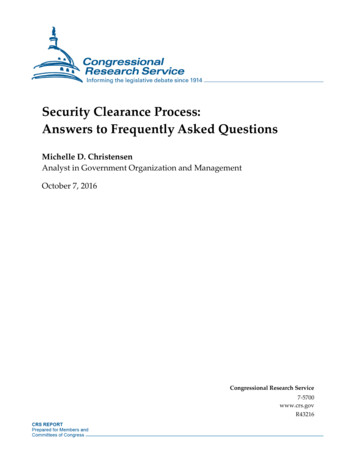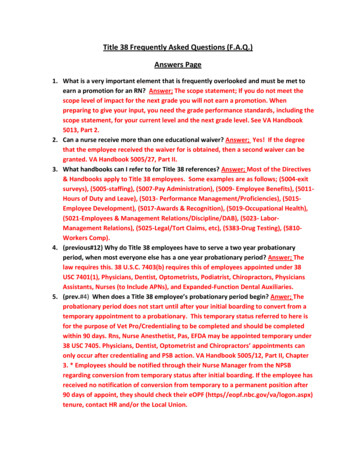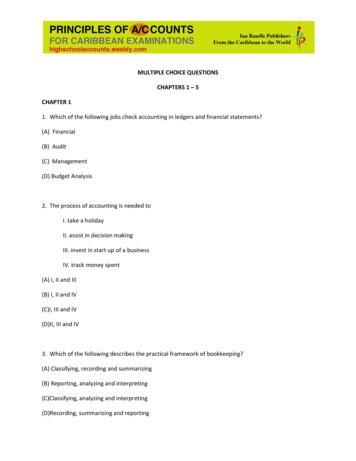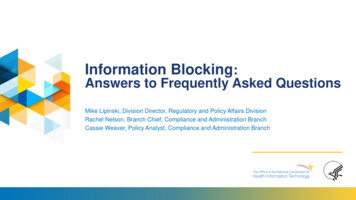
Transcription
Information Blocking:Answers to Frequently Asked QuestionsMike Lipinski, Division Director, Regulatory and Policy Affairs DivisionRachel Nelson, Branch Chief, Compliance and Administration BranchCassie Weaver, Policy Analyst, Compliance and Administration Branch
2Please Note: The materials contained in this presentation are based on the provisions contained in 45C.F.R. Parts 170 and 171. While every effort has been made to ensure the accuracy ofthis restatement of those provisions, this presentation is not a legal document. Theofficial program requirements are contained in the relevant laws and regulations. Pleasenote that other Federal, state and local laws may also apply. This communication is produced and disseminated at U.S. taxpayer expense.
3Education & Outreach Resources www.HealthIT.gov/CuresRule Factsheets Technical Assistance and Guides Continuing Medical Education and Other Continuing Education Credits Webinars and Other Presentations (ONC Speaker Request Form) Media/Press Health IT Buzz Blog Health IT Feedback and Inquiry Portal
4Got Questions?www.HealthIT.gov/feedback
Phone: 202-690-7151Contact ONCHealth IT Feedback Form:www.HealthIT.gov/feedbackTwitter: @onc healthITLinkedIn: Search “Office of the NationalCoordinator for Health Information Technology”Subscribe to our weekly eblastat healthit.gov for the latest updates!
6Information Blocking Definition(a) Information blocking means a practice that—(1) Except as required by law or covered by an exception, is likely to interfere with access, exchange, or useof electronic health information (EHI); and(2) If conducted by a health information technology developer, health information network or healthinformation exchange, such developer, network or exchange knows, or should know, that such practice islikely to interfere with access, exchange, or use of EHI; or(3) If conducted by a health care provider, such provider knows that such practice is unreasonable and islikely to interfere with the access, exchange, or use of EHI.(b) Until date specified in 45 CFR 171.103(b), EHI for purposes of §171.103(a) is limited to the EHIidentified by the data elements represented in the USCDI standard adopted in §170.213.
7Applicability Dates and EHI On and after April 5, 2021, an actor must respond to a request toaccess, exchange, or use EHI with, at a minimum, all requested EHIidentified by the data elements represented in the USCDI standard. On and after October 6, 2022, an actor must respond to a request toaccess, exchange, or use EHI with EHI as defined in § 171.102.Points of Interest:! Can be met if the actor does not have all the requested EHI.! Does not require EHI be held in or shared using specific technology orparticular technical standards.! Can be met where some EHI actor has restricted by law or permissible towithhold, such as consistent with Preventing Harm or Privacy Exception.
8Compliance and Enforcement Timeline ONC Health IT Certification Program - On April 5, 2021, developers of certifiedhealth IT will be subject to the “information blocking” condition of certificationfound in 45 CFR 170.401. Civil Monetary Penalties - Enforcement of information blocking civil monetarypenalties (CMPs) will not begin until established by future rulemaking by OIG. Asa result, actors will not be subject to penalties until the CMP rule is final.o At a minimum, the timeframe for enforcement will not begin sooner than thecompliance date of the ONC final rule and will depend on when the CMPrules are final.o Discretion will be exercised such that conduct that occurs before the CMPrule is final will not be subject to information blocking CMPs.
9January 2021 FAQs
10Information Blocking FAQs - GeneralQ: Do the information blocking regulations require actors to have or usecertified health IT, or upgrade the certified health IT they already have, inorder to fulfill a request to access, exchange, or use electronic healthinformation?No. The information blocking regulations do not require actors to have oruse health IT certified under the ONC Health IT Certification Program.Actors subject to the information blocking regulations are not required toimmediately upgrade their certified health IT (as of the applicability date(i.e., April 5, 2021)) if they also happen to participate in a separateregulatory program that requires the use of certified health IT, such as CMS’Promoting Interoperability Programs.
11Information Blocking FAQs - InterferenceQ: Do the information blocking regulations (45 CFR Part 171) requireactors to proactively make electronic health information (EHI) availablethrough “patient portals,” application programming interfaces (API), orother health information technology?No. There is no requirement under the information blocking regulations to proactively makeavailable any EHI to patients or others who have not requested the EHI. We note, however,that a delay in the release or availability of EHI in response to a request for legallypermissible access, exchange, or use of EHI may be an interference under the informationblocking regulations (85 FR 25813, 25878). If the delay were to constitute an interferenceunder the information blocking regulations, an actor’s practice or actions may still satisfy theconditions of an exception under the information blocking regulations (45 CFR 171.200-303).
12Information Blocking FAQs - InterferenceQ: Are actors (for example, health care providers) expected to releasetest results to patients through a patient portal or applicationprogramming interface (API) as soon as the results are available to theordering clinician?While the information blocking regulations do not require actors to proactively makeelectronic health information (EHI) available, once a request to access, exchange or useEHI is made actors must timely respond to the request (for example, from a patient for theirtest results). Delays or other unnecessary impediments could implicate the informationblocking provisions.In practice, this could mean a patient would be able to access EHI such as test results inparallel to the availability of the test results to the ordering clinician.
13Information Blocking FAQs - InterferenceQ: When a state or federal law or regulation, such as the HIPAA PrivacyRule, requires EHI be released by no later than a certain date after arequest is made, is it safe to assume that any practices that result in therequested EHI’s release within that other required timeframe will neverbe considered information blocking?No. The information blocking regulations (45 CFR Part 171) have their own standaloneprovisions (see 42 U.S.C. 300jj-52). The fact that an actor covered by the information blockingregulations meets its obligations under another law applicable to them or its circumstances(such as the maximum allowed time an actor has under that law to respond to a patient’srequest) will not automatically demonstrate that the actor’s practice does not implicate theinformation blocking definition.If an actor who could more promptly fulfill requests for legally permissible access, exchange,or use of EHI chooses instead to engage in a practice that delays fulfilling those requests, thatpractice could constitute an interference under the information blocking regulation, even ifrequests affected by the practice are fulfilled within a time period specified by a differentapplicable law.
14Information Blocking FAQs - InterferenceQ: Is it information blocking when state law requires a specific delay incommunication of EHI, or that certain information be communicated tothe patient in a particular way, before the information is made availableto the patient electronically?No. The definition of information blocking (45 CFR 171.103) does not include practices thatinterfere with access, exchange or use of EHI when they are specifically required byapplicable law (see 85 FR 25794). To the extent the actor’s practice is likely to interfere withaccess, exchange, or use of EHI beyond what would be specifically necessary to complywith applicable law, the practice could implicate the information blocking definition.
15Information Blocking FAQs – Preventing Harm ExceptionQ: Do the Preventing Harm Exception requirements for the type of harmalign with the HIPAA Rules?Yes. The Preventing Harm Exception’s type of harm condition relies on the same types ofharm that serve as grounds for reviewable denial of an individual’s right of access under thePrivacy Rule (45 CFR 164.524). (See ONC Cures Act Final Rule preamble Table 3—Mappingof Circumstances Under §171.201(d) to Applicable Harm Standards.) In most instances,including where a practice interferes with a patient’s own or the patient’s other health careproviders’ legally permissible access, exchange, or use of the patient’s electronic healthinformation (EHI), coverage under the Preventing Harm Exception requires that the risk be ofphysical harm. (See 45 CFR 171.201(d)(3) and (4).)However, the Preventing Harm Exception’s type of harm condition applies a “substantialharm” standard for practices interfering with a patient’s representative’s requested access,exchange, or use of the patient’s EHI and to the patient’s or their representative’s access toother persons’ individually identifiable information within the patient’s EHI in somecircumstances. (See 45 CFR 171.201(d)(1) and (2)).
16Information Blocking FAQs – Preventing Harm ExceptionQ: Will the Preventing Harm Exception cover practices interfering with apatient’s access, exchange, or use of their EHI only for the purposes ofreducing an imminent or immediate risk of harm?No. The reasonable belief condition does not include a requirement that the harm beexpected to occur within a particular time period or that the likelihood of the harm be highenough to be considered “imminent.” (See 45 CFR 171.201(a)). The Preventing HarmException’s reasonable belief condition requires an actor engaging in a practice likely tointerfere with a patient’s access, exchange, or use of their own EHI to have a reasonablebelief that the practice will substantially reduce a risk to life or physical safety of the patientor another person that would otherwise arise from the affected access, exchange, or use.
17Information Blocking FAQs – Preventing Harm ExceptionQ: Would the Preventing Harm Exception cover a “blanket” several daydelay on the release of laboratory or other test results to patients so anordering clinician can evaluate each result for potential risk of harmassociated with the release?(1/2) No. Blanket delays that affect a broad array of routine results do not qualify for the PreventingHarm Exception. The Preventing Harm Exception is designed to cover only those practices that are nobroader than necessary to reduce a risk of harm to the patient or another person.As we discussed in the Cures Act Final Rule, a clinician generally orders tests in the context of aclinician-patient relationship. In the context of that relationship, the clinician ordering a particular testwould know the range of results that could be returned and could prospectively formulate, in theexercise of their professional judgment, an individualized determination for the specific patient that: witholding the results of the particular test(s) from the patient would substantially reduce a risk to thepatient’s or another person’s life or physical safety - or that witholding the results of the particular test(s) from a representative of the patient wouldsubstantially reduce a risk of substantial harm to the patient or another person.
18Information Blocking FAQs – Preventing Harm Exception(continued) Q: Would the Preventing Harm Exception cover a “blanket”several day delay on the release of laboratory or other test results topatients so an ordering clinician can evaluate each result for potentialrisk of harm associated with the release?(2/2) Such individualized determinations made in good faith by an ordering clinician, in theexercise of their professional judgment and in the context of the treatment relationship withinwhich they order the test, would satisfy the type of risk and type of harm conditions of thePreventing Harm Exception. Actors, including but not limited to the ordering clinician, couldimplement practices in reliance on such determinations and the Preventing Harm Exceptionwould cover such practices so long as the practices also satisfy the other four conditions ofthe exception.
19Information Blocking FAQs – Preventing Harm ExceptionQ: Where the patient is a minor and to avoid breaching the patient’sconfidentiality and trust with the provider, will the Preventing Harmexception cover an actor’s practices that interfere with a parent or legalrepresentative’s access, exchange, or use of the minor’s EHI?No. Unless an actor reasonably believes a practice that interferes with a parent or otherlegal representative’s requested access, exchange, or use of the minor’s electronic healthinformation (EHI) will substantially reduce a risk of at least substantial harm to the patientor another person, the Preventing Harm Exception is not designed to cover that practice.The Privacy Exception contains a sub-exception (45 CFR 171.202(e)) that covers practicesrespecting an individual’s request not to share information, subject to certain conditions.
20Information Blocking FAQs – Preventing Harm ExceptionQ: Where the patient is a minor and to reduce a risk of harm other thanphysical abuse, will the Preventing Harm Exception cover an actor’spractices that interfere with a parent or legal guardian’s access,exchange, or use of the minor’s EHI?(1/2) Yes, where the risk of harm has been determined on an individualized basis and all otherconditions of the Preventing Harm Exception are met. For example, the practice must be nobroader than necessary and the actor must reasonably believe the practice will substantiallyreduce the risk of harm. (For all the conditions of the Preventing Harm Exception, please see 45CFR 171.201.)For purposes of the Preventing Harm Exception, a parent or legal guardian would beconsidered a patient’s legal representative. The Preventing Harm Exception’s type ofharm condition applies a “substantial harm” standard for practices interfering with apatient’s representative’s requested access, exchange, or use of the patient’s EHI. (See 45CFR 171.201(d)(1)).
21Information Blocking FAQs – Preventing Harm Exception(continued) Q: Where the patient is a minor and to reduce a risk of harmother than physical abuse, will the Preventing Harm Exception cover anactor’s practices that interfere with a parent or legal guardian’s access,exchange, or use of the minor’s EHI?(2/2) The type of harm conditions for Preventing Harm Exception coverage of practicesinterfering with patients’ and their representatives’ access to EHI on the basis of anindividualized determination of risk are specifically aligned with the HIPAA Privacy Rule’sgrounds for reviewable denial of an individual’s right of access under the Privacy Rule.(See also ONC Cures Act Final Rule preamble discussion and Table 3—Mapping ofCircumstances Under §171.201(d) to Applicable Harm Standards).
22Questions
7 On and after April 5, 2021, an actor must respond to a request to access, exchange, or use EHI with, at a minimum, all requested EHI identified by the data elements represented in the USCDI standard. On and after October 6, 2022, an actor must respond to a request to access, exchange, or use EHI with EHI as defined in §171.102. Applicability Dates and EHI
